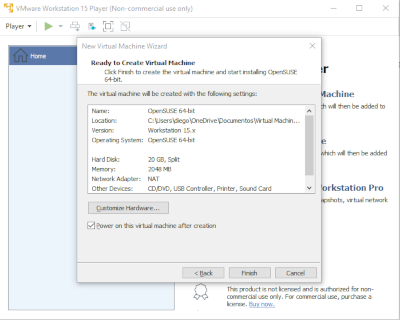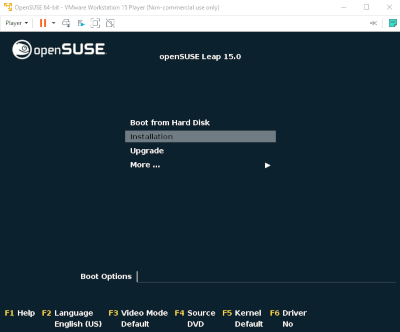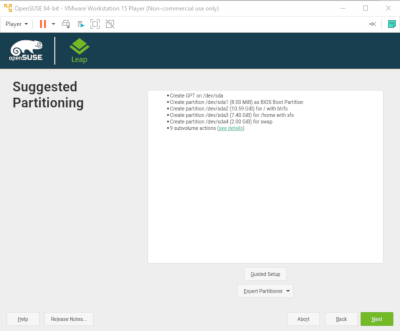In this step by step, we are going to install openSuse Leap in a Virtual Machine.
Prerrequisite
To have one virtual machine software already installed. If you need the step by step - Installing VMWare Workstation you can click here, before continue this guide. If you preffer, you can use also: Oracle VM VirtualBox.
Step 1
To install the Linux Operating System openSuse Leap, the first step is to download the Installer. You can download it from the official page OpenSuse.org, just click here.

Step 2
Click on Image DVD to download the entire installer in ISO format. The download will take from minutes to some hours, depending of your internet connection speed.

Step 3
When the openSuse installer download is complete, we can begin with the virtual machine creation, for this, open VMWare Workstation Player and make click on the "Create a New Virtual Machine" option.

Step 4
In the "Create a New Virtual Machine" screen, select the option Installer disk image file (iso) and browse the downloaded ISO installer in the Step 2. Click on the next button to continue.

Step 5
In this screen you can choose the Virtual Machine Name and the location where the machine will be installed. Edit this settings or accept the default values and continue, clicking on the next button.

Step 6
Now you can adjust two important settings about the new virtual machine: The first is the disk size, having by default 20GB (this is enought for the openSuse Installation) and the second setting is the way you can save this virtual hard drive, choosing from one single file or multiple files, I recommend you to use multiple files. Click the next button.

Step 7
In this screen you can see that many other details of the Virtual Machine were chosen automatically, if you need it, you can customize them making click in the Customize Hardware button. The tipical changes to do are: Modify the assigned RAM or the numbers of CPU. Remember that you need to assign resources without affecting the host machine. For example, if your host machine have a total of 16GB in RAM, you could assign to your virtual machine around of 8GB of RAM. Click in the Finish button to continue.

Step 8
If you did the previuos steps fine, the new virtual machine is initiated in this moment and you'll see the OpenSuse welcome screen. There we can choose the Installation option y push the key Enter to continue.

Step 9
After some minutes, the installer wizard begin and it show the screen where you need set the Language and keyboard layout. The keyboard layout offer you one keyboard test field in order to check if the keyboard distribution selected is correct. Click on the next button to continue

Step 10
Now you can select the system role. In our case, select the Desktop role with KDE or GNOME distribution and click on the Next button.

Step 11
This screen is really important, because the installer show you how is going to distribute the disk space. Check the home partition, there is where your personal files are going to be stored. If you want to modify these settings, you can choose the Guided Setup or the Expert Partition. Click next to continue.

Step 12
Now, you can choose the clock and timezone, just click in the map your country to set these parameters. Click in the next button to continue.

Step 13
In the next screen, you can set the user full name, username and password for the admin user. Click in the next button.

Step 14
Now you can see an installation resume, check that several settings are set by default. for example, Firewall enable, SSH port blocked and others, you can adjust directly here if you need. Click on the Install button to begin the openSuse installation.

Step 15
The installation process begin here, and the installer is copying the required files.

Step 16
When the installation process is complete, the virtual machine is restarted and in some seconds the openSuse Leap is ready to use.



